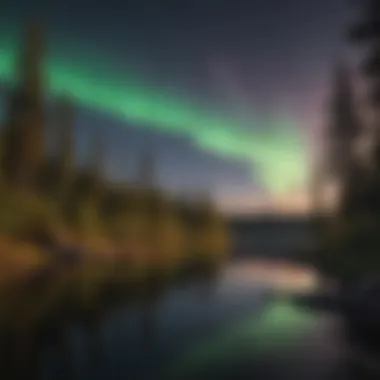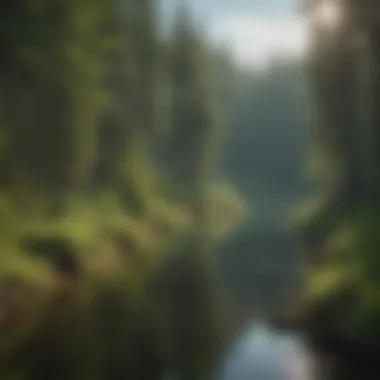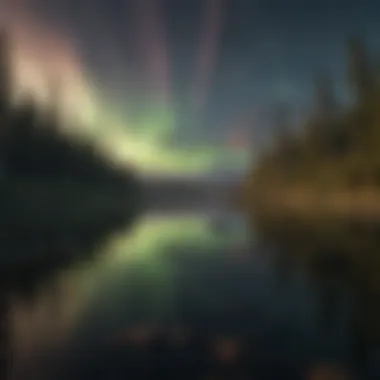Exploring Minnesota's Boundary Waters and Northern Lights


Intro
The Boundary Waters region of Minnesota captivates those who seek beauty and tranquility in nature. One can experience a remarkable intersection of ecological diversity and celestial wonders here. This region presents exceptional forest ecosystems that thrive alongside the ethereal dance of the Northern Lights. Understanding this rich interplay is essential for those who care about environmental sustainability and the preservation of cultural heritage.
The Northern Lights, or Aurora Borealis, have fascinated humans for centuries. This awe-inspiring phenomenon reflects the interaction of solar winds with the Earth’s magnetic field. Observing this spectacle in the crisp air of the Boundary Waters is an experience that lends a sense of wonder and connection to the universe.
In this article, we will explore the ecological and cultural significance of the Boundary Waters. From the forest ecology and biodiversity that characterize this region to the sustainable practices that aim to protect it, we will cover essential discussions about stewardship and community involvement.
Forest Ecology and Biodiversity
The forest ecology of the Boundary Waters is vital not only for its beauty but also for the numerous species that depend on it. This area is renowned for its diverse ecosystems, which support various flora and fauna.
Importance of Forest Ecosystems
Forest ecosystems contribute significantly to local and global ecology. They act as carbon sinks, absorbing carbon dioxide and mitigating climate change. Moreover, these natural wonders filter water, maintain soil integrity, and provide habitat for countless species. The Boundary Waters, as a designated wilderness area, exemplifies these ecological roles.
Flora and Fauna in Woodlands
In the woods of the Boundary Waters, one can find an impressive array of life.
- Plants: These include towering pines, maples, and birches. Each tree species plays a crucial part in supporting the ecosystem. For instance, the diversity in trees allows for various habitats, promoting healthy wildlife populations.
- Wildlife: One can spot multiple species, such as the bald eagle, moose, and black bear. These creatures adapt to their surroundings, showcasing an intricate balance within the ecosystem.
Engaging in the study of such biodiversity is essential for any forestry professional. Understanding the nuances of these species helps in creating informed conservation strategies.
"Forests are not only trees and wildlife; they are the foundation of healthy ecosystems and vibrant communities."
Sustainable Forestry Practices
Sustainable forestry is critical in maintaining the health of the Boundary Waters and surrounding areas. Balancing resource extraction with ecological preservation is imperative in today’s rapidly changing world.
Techniques for Responsible Management
To ensure sustainability, various techniques are employed, such as:
- Selective logging, which allows for the preservation of tree diversity.
- Controlled burns, which rejuvenate forest health and reduce wildfire risks.
- Continuous monitoring of ecosystem changes to adapt management strategies.
These methods are essential for promoting resilience in forest ecosystems.
Certification Schemes and Standards
Many forestry practices in this region utilize certification schemes to promote sustainable practices. Brands like the Forest Stewardship Council (FSC) and Sustainable Forestry Initiative (SFI) set high standards for responsible forest management, ensuring that timber extraction does not harm the environment. Such certifications increase market demand for sustainably sourced timber and raise community awareness about ecological responsibility.
Community Engagement and Stewardship
Local communities play a critical role in the stewardship of the Boundary Waters. Their involvement is crucial for effective conservation efforts and maintaining cultural connections.
Role of Local Communities
Residents understand the land intimately. Their traditional knowledge complements scientific research, creating a holistic approach to forest management. Communities advocate for sustainable practices and engage in conservation projects that benefit both nature and people.
Volunteer Opportunities for Engagement
Those interested in contributing can find various volunteer opportunities:
- Participating in tree-planting initiatives.
- Engaging in wildlife monitoring programs.
- Assisting with educational outreach efforts to inform the public about the ecological significance of the Boundary Waters.
By getting involved, individuals can help foster a sense of shared responsibility for the environment.
Understanding the complex dynamics between the Boundary Waters and the Northern Lights opens avenues for greater appreciation and conservation efforts. The insights gathered from such studies can inspire actions essential for preserving these natural treasures for future generations.
Understanding the Boundary Waters


The Boundary Waters region of Minnesota consists of over a million acres of pristine wilderness, characterized by its interconnected lakes and forests. Understanding this area is crucial for grasping the interactions between ecological, social, and historical factors. This article will discuss its geographical features, ecological significance, and rich cultural context. The Boundary Waters is not just a natural resource; it embodies a complex relationship between human activity and conservation, making it a focal point for sustainability and environmental responsibility.
Geographical Overview
The geographical layout of the Boundary Waters is both stunning and intricate. It features more than 1,000 lakes and rivers winding through the landscape, bordered by the Canadian wilderness to the north and the Chippewa National Forest to the south. This vast expanse creates a mosaic of habitats. The water bodies are fed by numerous streams, which are critical for maintaining ecological balance. Navigating through the area often requires portaging, an activity that enhances the experience of immersing oneself in nature.
Ecological Significance
The ecological value of the Boundary Waters cannot be overstated. It acts as a refuge for several species and serves as an important area for biodiversity. Here's a closer look at its significance.
Flora and Fauna Diversity
The region showcases a rich variety of plant and animal species. Over 1,000 species of plants can be found here along with wildlife such as moose, wolves, and a variety of birds. This diversity plays a vital role in ecosystem stability. Healthy plant life supports animal populations, which in turn maintain the ecological balance. The specific conditions of the different habitats within the Boundary Waters allow for unique species adaptations, contributing to a dynamic ecosystem. This feature makes the area invaluable for study and conservation efforts.
Habitat Conservation
Conservation efforts in the Boundary Waters focus on maintaining the integrity of diverse habitats. Effective management practices are essential to protect these natural environments from threats such as invasive species and climate change. Key conservation initiatives include habitat restoration and monitoring ecosystem health. These efforts uphold not only ecological functions but also cultural connections by preserving lands that hold historical significance for Indigenous communities. Habitat conservation is vital for supporting species populations and ensuring that ecological processes continue.
Biodiversity Hotspots
The Boundary Waters is classified as a biodiversity hotspot, indicating its significance for global conservation. These hotspots are characterized by high levels of species diversity and are often under threat from human activities. The unique geographical features support a variety of ecosystems that harbor native and endemic species. Protecting these areas is essential; they play a crucial role in ecological resilience, providing ecosystem services such as water purification, soil formation, and carbon storage. The designation of biodiversity hotspots emphasizes the urgent need for conservation action.
Cultural and Historical Context
Understanding the cultural and historical implications of the Boundary Waters enhances appreciation for the region. The interplay between Indigenous peoples and the landscape offers important insights.
Indigenous Heritage
The Indigenous peoples of the region have a deep-rooted connection to the Boundary Waters, viewing it as an integral part of their cultural identity. Their traditions and practices shape the understanding of responsible stewardship of these lands. Indigenous knowledge provides valuable perspectives on sustainable living and ecosystem management. This heritage is not merely historical; it informs contemporary practices and advocacy in conservation efforts. Recognizing Indigenous heritage enriches the narrative around the Boundary Waters and highlights the need for inclusive conservation strategies.
Early European Exploration
The early European explorations of the Boundary Waters brought significant changes to the area. Explorers documented the landscape while often disregarding established Indigenous practices. These encounters set the stage for subsequent economic exploitation and land management challenges. Despite this, early exploration also contributed to the mapping and documenting of the region's natural resources. Learning from these historical events emphasizes the potential pitfalls in dealing with land management, as well as the importance of integrating diverse perspectives in contemporary environmental practices.
Contemporary Uses
Today, the Boundary Waters serves multiple purposes. It attracts tourists seeking recreation, adventure, and solitude. Activities such as canoeing, hiking, and fishing coexist with ongoing conservation efforts. The increasing interest in the area raises questions about balancing recreational use with preservation. Managing this duality is essential to ensure the sustainability of the environment while also respecting cultural and historical contexts. The diverse uses of the Boundary Waters signify its relevance across generations, reinforcing the argument for its continued protection.
The Boundary Waters is more than just a beautiful landscape; it is a complex system interwoven with ecological, cultural, and historical threads. Understanding these factors is imperative for future conservation efforts.
Forestry Practices in the Boundary Waters
The Boundary Waters region represents a crucial ecosystem where forestry practices play a vital role in maintaining ecological balance and supporting local communities. This area is not just about trees; it reflects sustainable management of resources. Forestry practices here help in protecting the landscape, preserving biodiversity, and contributing to the economy through responsible logging and conservation efforts.
Sustainable Forestry Techniques
Sustainable forestry techniques promote the responsible use of forest resources, ensuring that forests can continue to thrive. Among these techniques, selective logging and reforestation initiatives stand out.
Selective Logging
Selective logging involves the careful removal of specific trees. This method aims to minimize damage to the surrounding environment while allowing some trees to remain for future generations.
- Contribution to Goals: Selective logging supports ecological stability. By carefully choosing which trees to log, it maintains the overall health of the forest.
- Key Characteristics: It is a more benificial practice compared to clear-cutting as it leaves the forest structure intact.
- Unique Features: One unique feature of selective logging is that it encourages biodiversity. By not removing all trees, habitats for various species remain protected.
- Advantages and Disadvantages: The advantages include reduced soil erosion and better wildlife habitat. However, it may still face critism for being labor-intensive and requiring skilled workers, which can increase costs.
Reforestation Initiatives
Reforestation initiatives focus on planting trees in deforested or degraded areas. They are crucial to restoring ecosystems disrupted by logging or climate change.
- Contribution to Goals: The initiatives help enhance carbon sequestration, combating climate change.
- Key Characteristics: They are often community-involved projects, promoting local stewardship and engagement.
- Unique Features: Reforestation can utilize native species, ensuring that landscapes are restored authentically.
- Advantages and Disadvantages: The advantages include restoring wildlife habitats and improving air quality. However, challenges like invasive species can arise, potentially undermining these efforts.
Impact of Climate Change


Climate change poses severe threats to forestry practices. Its impacts are visible in species distribution and additional challenges for forest management.
Shifts in Species Distribution
Shifts in species distribution indicate how climate change alters forest ecosystems. Different tree species may move northward or to higher elevations as temperatures rise.
- Contribution to Goals: Understanding these shifts helps in future forestry planning and conservation.
- Key Characteristics: This aspect is crucial for maintaining the ecological balance as new species will fill roles.
- Unique Features: Species like maple may move out as birch and pine become more dominant in certain areas.
- Advantages and Disadvantages: Advantages include a potentially more resilient ecosystem; however, such shifts also threaten native species, which may struggle to adapt.
Forest Management Challenges
The challenges faced in forest management due to climate change are significant. They require adaptability and proactive planning.
- Contribution to Goals: These challenges underscore the necessity for updated management strategies that consider climate variability.
- Key Characteristics: Issues such as increased pest outbreaks and wildfires become more common.
- Unique Features: Managers must implement new strategies, like creating fire breaks, to mitigate these risks.
- Advantages and Disadvantages: Enhanced preparedness can lead to healthier forest systems but may demand significant resources and shift in policies.
Community Engagement in Forestry
Community involvement plays a pivotal role in the sustainability of forestry practices. Local conservation groups and educational programs are instrumental in fostering a deeper connection to the land.
Local Conservation Groups
Local conservation groups work tirelessly to protect forest ecosystems. They foster community ownership of natural resources.
- Contribution to Goals: Such groups are integral to advocating for sustainable practices and policies.
- Key Characteristics: These organizations often focus on reducing illegal logging and protecting wildlife habitats.
- Unique Features: Community support makes their initiatives more effective and grounded in local needs.
- Advantages and Disadvantages: The advantages include grassroots engagement leading to more effective conservation. On the downside, reliance on volunteers may limit capacity.
Educational Programs
Educational programs are designed to raise awareness about sustainable forestry and environmental stewardship.
- Contribution to Goals: They aim to inform the public and promote conservation behaviors.
- Key Characteristics: Programs often target schools and community groups.
- Unique Features: Interactive workshops allow participants to learn hands-on about forest ecosystems.
- Advantages and Disadvantages: Such education can foster a culture of sustainability. However, inconsistent funding may affect program availability.
Community engagement in forestry not only enhances conservation efforts but also builds a collective identity centered around stewardship of the land, which is essential for the future of the Boundary Waters.
The Northern Lights Phenomenon
The Northern Lights, or Aurora Borealis, holds a significant place in the narrative of the Boundary Waters region. This natural light display captivates many people. It is not just an aesthetic phenomenon; it also provides insight into science, culture, and recreation. Understanding this phenomenon adds depth to the exploration of the Boundary Waters, which is already rich in ecological and historical significance.
Scientific Explanation of Aurora Borealis
Solar Winds and Earth’s Magnetic Field
Solar winds are streams of charged particles released from the sun. When these particles collide with Earth’s magnetic field, they shape the aurora. This interaction is fundamental to the overall phenomenon of the Northern Lights. The key characteristic of solar winds is how they travel across space, carrying energy that generates the light displays seen on Earth. This is a beneficial aspect because it clarifies the science behind the auroras.
The unique feature of solar winds is their speed and variability. They can reach Earth in just a few days, which allows for short-term forecasting of aurora activity. However, predicting specific colors or patterns remains challenging.
Color Variability in Auroras
The color variability in auroras comes from the different gases in Earth’s atmosphere. Oxygen produces green and red hues, while nitrogen shows blue and purple shades. This variability contributes to the complexity of the aurora phenomenon. It is a beneficial aspect to discuss because it enhances the appreciation for the scientific intricacies involved.
Different atmospheric conditions can enhance or suppress certain colors. This aspect adds another layer to understanding auroras from a scientific perspective. The color variability could influence how people interpret and experience the Northern Lights.
Optimal Viewing Conditions
Best Times of Year
The best times to witness the Northern Lights are typically from late September to early April. This period coincides with increased solar activity and longer nights. Understanding the optimal viewing times assists in planning trips to the Boundary Waters, which further aligns with the article's goal of maximizing visitor experiences.
Additionally, during winter months, the skies are clearer. This enhances the chances of a successful viewing. Consistently experiencing the lights can shift expectations. Thus, knowing the best times is important for potential visitors.
Geographic Considerations
Geographic location significantly influences aurora visibility. The Boundary Waters, with its remote and dark skies, serves as an ideal location. Areas away from city lights offer the best conditions for viewing. Highlighting geographic considerations helps to underscore the unique natural advantages of the Boundary Waters for this experience.


Moreover, different geographic regions may have distinct experiences. For instance, locations further north generally have more frequent aurora displays. It is essential to understand these factors when considering the best places to enjoy the Northern Lights.
Cultural Interpretations of the Northern Lights
Mythologies Across Cultures
Many cultures have mythologies surrounding the Northern Lights. Inuit tribes, for example, viewed auroras as spirits of ancestors, creating a rich cultural narrative. Discussing these mythologies contributes to the cultural relevance of the Northern Lights in this article. It adds depth to the experience, showcasing how these lights resonate with human beliefs and traditions.
Each culture's interpretation provides a unique lens through which to view the phenomenon. The advantage is that it invites more diverse perspectives on the same physical occurrence, enriching the overall dialogue.
Contemporary Art and Expression
In contemporary times, artists often draw inspiration from the Northern Lights. This can be seen in various art forms, from paintings to digital media. Engaging with contemporary art related to the auroras expresses how they continue to inspire today. This emphasis also highlights an important aspect of cultural continuity. Artists capture the experience of the lights, which connects both the past and present for many people.
The unique feature of contemporary art is its ability to evoke emotion related to nature’s beauty. This can influence how people experience and share their own encounters with the Northern Lights. Incorporating art into this conversation adds layers to understanding the cultural impact of this natural phenomenon.
The Intersection of Recreation and Conservation
Recreation and conservation in the Boundary Waters play a critical role in preserving this unique environment while allowing people to connect with nature. This relationship is essential as it balances human enjoyment with the need to protect the ecosystem. Recreational activities, when conducted responsibly, can foster a greater appreciation for nature, leading to stronger advocacy for conservation efforts.
Moreover, responsible recreation serves as a tool for raising awareness about ecological issues. Engaging in outdoor activities in this area can highlight the significance of preserving habitats, thus influencing public opinion and policy regarding environmental protection. There are multiple dimensions to explore in this intersection, including the various recreational activities available in the Boundary Waters and the principles that ensure these activities contribute positively to conservation efforts.
Recreational Activities in the Boundary Waters
Canoeing and Kayaking
Canoeing and kayaking are among the most popular choices for recreation in the Boundary Waters. These activities allow visitors to navigate the numerous lakes and rivers while experiencing the area’s stunning natural beauty. The calm waters provide an accessible way for individuals of different skill levels to engage with the environment.
One key characteristic of these water activities is that they promote a low-impact approach to recreation. Paddling does not produce significant noise or pollution, allowing wildlife to thrive nearby. Furthermore, being on the water provides unique opportunities to observe flora and fauna, enhancing the overall experience. An advantage of canoeing and kayaking is the sense of serenity they offer. Being surrounded by nature while gliding across the water fosters a deep connection with the environment. But, both activities also require adequate safety precautions and awareness of weather conditions, which can limit accessibility for some participants.
Hiking and Wildlife Observation
Hiking and wildlife observation are equally important in promoting eco-tourism in the Boundary Waters. These activities not only cover vast stretches of land but also encourage appreciation of the diverse ecosystems present. Trails often provide access to different habitats, making it easier to spot various species in their natural settings.
A significant characteristic of hiking is its accessibility; it caters to various fitness levels, allowing anyone to explore the natural world. The act of walking through the woods or along lakeshores allows for deeper immersion in the landscape. Wildlife observation enhances this experience, as one can witness animals in their natural behavior. Hiking is beneficial for physical health and mental well-being. However, individuals engaging in these activities must remain aware of their impact on the environment. Disturbance to sensitive areas can have detrimental effects, highlighting the importance of responsible practices.
Responsible Recreation Practices
Leave No Trace Principles
The Leave No Trace principles are essential for minimizing human impact during recreational activities. These principles focus on ensuring that outdoor enthusiasts leave natural areas as they found them. Integrating these concepts into recreational experiences can significantly contribute to the overall goal of preserving the Boundary Waters.
One key characteristic of Leave No Trace principles is their holistic approach. The principles cover various aspects, including proper waste disposal, respecting wildlife, and minimizing campfire impacts. Following these guidelines enhances the experience for future visitors while ensuring that ecosystems remain intact. Its advantage lies in fostering a collective responsibility toward conservation efforts. Conversely, a challenge arises if individuals do not fully grasp these principles, leading to potential harm to the environment.
Impact Monitoring
Regular impact monitoring is vital for assessing the effects of recreational activities on the Boundary Waters. Monitoring offers valuable data on how human presence influences ecosystems, habitats, and wildlife. Implementing systematic observation can identify trends and areas where intervention may be necessary to protect resources.
A key characteristic of impact monitoring is its ability to adaptively manage visitor usage based on observed outcomes. This responsiveness enables conservationists to adjust regulations and guidelines to better serve the environment. It supports sustainable recreation and ensures that the ecosystem is not compromised due to recreational demands. However, impact monitoring requires consistent resources and commitment, which can be challenging in certain contexts.
End
The conclusion serves as a pivotal reflection on the themes discussed throughout the article. The Boundary Waters of Minnesota and the phenomenon of the Northern Lights present a stunning example of how nature's beauty can coexist with human activity, education, and conservation efforts. As this discussion unfolds, it becomes clear that understanding and preserving these wonders is not just an environmental concern but also a cultural imperative.
The Future of the Boundary Waters
Looking ahead, the future of the Boundary Waters is intertwined with various factors. The escalating effects of climate change can potentially alter its ecosystems in unforeseen ways. It is essential to prioritize sustainability to ensure the region's natural beauty is maintained for generations to come. Key considerations include:
- Water Quality Management: Continuous monitoring of waterways to protect aquatic life.
- Habitat Protection: Ensuring the diverse species find sanctuary amidst human development.
- Sustainable Tourism: Encouraging responsible visitor practices that support conservation rather than detract from it.
Engagement from local communities, stakeholders, and forestry professionals will be essential. Collaborating on policies and promoting awareness will benefit not only the region but the wider environmental health as well.
Ongoing Conservation Efforts
Conservation efforts in the Boundary Waters region are critical. Organizations dedicated to preserving this unique environment have been active for many years. Some notable strategies include:
- Restoration Projects: Rehabilitating degraded areas to rejuvenate ecosystems.
- Education Programs: Informing the public about the importance of biodiversity and ecological balance.
- Technology Integration: Utilizing innovative monitoring methods to track changes in wildlife populations and native plant growth.
By supporting these initiatives, the cultural significance of the Boundary Waters, alongside its ecological roles, can be safeguarded. The intertwined relationship of recreation, conservation, and community efforts will yield joint benefits for both nature and future generations.















